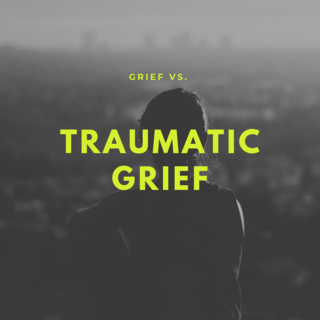Trauma
Grief vs. Traumatic Grief
Dealing with unexpected loss.
Posted September 29, 2019 Reviewed by Kaja Perina

One morning 20 years ago, my brother died unexpectedly. He was 37 years old, healthy, married with two kids. I was a trauma veteran already at that point, living with full-fledged PTSD symptoms from past experiences.
The death of my brother was debilitating to me and my family members. Our family had managed to cope with a number of previous losses and difficulties. But this one was different. My brother had played a key role in our ability to cope with health and financial challenges. When we lost him, it had a huge domino effect and the strong family structure that we had began to fade.
I was devastated, numb, and frightened to engage with life. I poured myself into work, which gave me a sense of meaning and purpose. Day by day, I survived on the push of deadlines and tasks that helped me wake up in the mornings and focus on something else. But I was not engaged with life.
Dominance of Fear
Almost four years later, I got a Fulbright scholarship to pursue a masters in the U.S. I was terrified to go. I did not really want to go, but I also did not want to stay. I felt numb and scared and did not recognize that my passion to study and find meaning and purpose was an expression of my passion to live. Fear was so dominating, it masked almost everything else.
Despite my fear, I moved to the US. I told myself that I would definitely come back in a few months, but at least I would know that I tried it.
Once there, I felt far away from everything and everyone I knew. I was in a small and—to me at least—remote mountain city. Full-fledged PTSD symptoms resurfaced and I lost my appetite.
I could eat less than a handful of a few things. It wasn’t that I decided not to eat. I couldn’t. I soon learned that I was in the grips of an instinctual survival response from earlier trauma experiences.
Trauma Was the Missing Link
A first step that helped me was learning about trauma and how it affected my fear responses. I began therapy again. My therapist told me—for the first time in my life—that I was traumatized (see blog post on that story). At about the same time, I took an Intro to Trauma class and was introduced to the writings of Peter Levine (a 1997 book) and Van der Kolk (a 1994 article). I could hardly believe how much sense these writings made for me and my life circumstances. That marked a major shift that ended up with me becoming a therapist and a scholar of trauma studies.
As I began looking at trauma from a therapeutic perspective, increasingly I felt a need for a framework.

In addition, my own experience impressed me with trauma’s capacity to take over everything. Virtually every aspect of my life had been altered in painful ways—from how I ate to how I slept, socialized, exercised, listened to music, and more. I wanted an intervention approach that recognized and addressed all these areas.
A third objective became increasingly important to me as well: the long-lasting impact of interventions—self-sustainability. In my own journey, I had discovered that often a new approach helped me feel better for a little while, but then it faded. From reading, and eventually from working with clients, I learned that this is a universal problem for trauma survivors. For myself and my clients, I saw that it’s important to have a framework of analysis and treatment that recognizes and has answers for this issue (see more here).
From this quest emerged what I now call the Expressive Trauma Integration (ETI) approach. It includes a theoretical roadmap laying out a non-linear cycle for describing what happens after trauma as a survivor moves towards trauma integration. The ETI framework points towards an integrative approach in treatment, that incorporates all aspects of life and focuses on building capacities for wellness.
My experience as a trauma survivor and now as a therapist convinces me that to be sustainable trauma treatment must target different aspects of well-being. A variety of useful modalities are available, but often the results of any one of them are inconsistent and limited in duration. However, together, they can have a great impact that endures across time.
In life, we all experience different variations of grief. At some point or another, we will all lose people that we love, capacities that we used to have, jobs that were life-giving, locations that we once enjoyed. Kubler-Russ described grief as five stages: Denial, Anger, Bargaining, Depression, Acceptance. We may experience these stages as a sequence or all at the same time, or we may experience only some of them. Grief is complex and each person has their own unique experience of it.
Traumatic grief, that is, the grief that accompanies loss that is unexpected, is different. Such a loss triggers post-trauma survival mechanisms in addition to the mourning of whatever was unexpectedly lost.
What degree of unexpectedness makes grief traumatic? That’s not definable. It varies from person to person.
Learning to Live With Fear
Fear is a part of life. Like most people, I know that. Yet, still after all these years, there are moments that I feel frozen with fear. Twenty years ago this month my brother died and I still feel frozen when I remember the moment when I learned he died.
Engaging with this traumatic loss using bottom-up modalities (movement, psychodrama, music, art-making) helped me learn to self-regulate and achieve some reduction in post-trauma stress and tension. Not perfect release, not perfect reduction, but enough to be able to engage with life and feel grief without triggering a hyper (fight/flight) or hypo (freeze) response.
I used narrative processing to work through my trauma. In doing that, I learned to reframe my worldview about myself and my past, I changed the way I defined healing, resilience and post-traumatic growth.
Moving Towards Integration
As a therapist, my main goal with clients is usually to support them to achieve trauma integration. What does that look like? As an example, here is a very brief summary of how (at this time, but it is still evolving) I understand my trauma experience after years of effort to move towards integration:
Since September 1999 life has been mixed. I am a survivor of several traumatic events as well as ongoing exposure to stress. I have lost things I am still sad about losing, including certain expectations for how things would turn out for my family and me.
Despite these losses, in this time I have able to do and gained many things that I never thought I would have or even dared to hope I would have. As a result, I have come to recognize my capacities, creativity, and even my vulnerabilities as a tremendous resource for living. I’ve been able to create a way of living with trauma that gives meaning and purpose, gratefully not just to me, but to many others who engage with the expressive trauma integration approach.
Facebook/LinkedIn image: fizkes/Shutterstock




